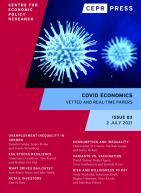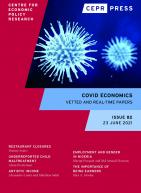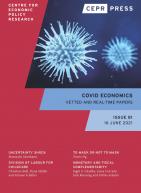
How do major pandemics affect economic activity in the medium to longer term? Is it consistent with what economic theory prescribes? Since these are rare events, historical evidence over many centuries is required. We study rates of return on assets using a dataset stretching back to the 14th century, focusing on 15 major pandemics where more than 100,000 people died. In addition, we include major armed conflicts that resulted in a similarly large death toll. Significant macroeconomic after-effects of the pandemics persist for about 40 years, with real rates of return substantially depressed. In contrast, we find that wars have no such effect, indeed the opposite. This is consistent with the destruction of capital that happens in wars, but not in pandemics. Using more sparse data, we find real wages somewhat elevated following pandemics. The findings are consistent with pandemics inducing labor scarcity and/or a shift to greater precautionary savings.
Citation
We classify the feasibility of working at home for all occupations. About 34% of US jobs, accounting for 44% of overall wages, can plausibly be performed at home. This share varies considerably across cities and industries. We hope our results are useful for understanding the economic impact of social distancing and formulating policy responses. Our classifications could be easiy applied to other countries.
Citation
Neiman, B and J Dingel (2020), ‘How Many Jobs Can be Done at Home?‘, COVID Economics 1, CEPR Press, Paris & London. https://cepr.org/publications/covid-economics-issue-1#392514_392877_391013
We investigate the impact of the German public shutdown from 13 March 2020 on the spread of Covid-19. In a simple model, we search for a trend break in cumulated confirmed Covid-19 cases as reported by the Johns Hopkins University (2020). We identify a trend break on 20 March that is in line with the expected lagged impact of the German policies and which reduces the growth rate by 48.2%. While the growth rate has almost halved, the number of cases is still doubling every 5.35 days.
Citation
Wälde, K, E Weber and T Hartl (2020), ‘Measuring the impact of the German public shutdown on the spread of COVID-19‘, COVID Economics 1, CEPR Press, Paris & London. https://cepr.org/publications/covid-economics-issue-1#392514_392877_390183
No previous infectious disease outbreak, including the Spanish flu, has impacted the stock market as powerfully as the Covid-19 pandemic. We use text-based methods to develop this point with respect to large daily stock market moves back to 1900 and with respect to overall stock market volatility back to 1985. We also argue that policy responses to the Covid-19 pandemic provide the most compelling explanation for its unprecedented stock market impact.
Citation
Viratyosin, T, M Sammon, K Kost, S Davis, N Bloom and S Baker (2020), ‘The Unprecedented Stock Market Impact of COVID-19‘, COVID Economics 1, CEPR Press, Paris & London. https://cepr.org/publications/covid-economics-issue-1#392514_392877_390366
I estimate the susceptible-infected-recovered (SIR) epidemic model for the novel coronavirus disease (Covid-19). The transmission rate is heterogeneous across countries and far exceeds the recovery rate, which enables a fast spread. In the benchmark model, 24.4% of the population may be simultaneously infected at the peak, potentially overwhelming the healthcare system. The peak reduces to 5.6% under the optimal mitigation policy that controls the timing and intensity of social distancing. A stylised asset pricing model suggests that the stock price temporarily decreases by 50% in the benchmark case but shows a W-shaped, moderate but longer bear market under the optimal policy.
Citation
Toda, A (2020), ‘Susceptible-Infected-Recovered (SIR) Dynamics of COVID-19 and Economic Impact‘, COVID Economics 1, CEPR Press, Paris & London. https://cepr.org/publications/covid-economics-issue-1#392514_392877_390367
The lack of anticipation of a worldwide disruptive event such as the spread of Covid-19, combined with the breakdown of market mechanisms for the most essential products needed to fight the disease, has left the governments of many countries unsure of how to react and has often constrained their ability to make strategic choices. The humanitarian goal of saving as many lives as possible has come, in some countries, at the cost of confining the entire population, considered the only option available given the circumstances. The economic cost of such a solution, which brings the economies of these countries to a standstill and disrupts global value chains, is likely to be followed by several years of economic depression that will dwarf the cost of the 2008 financial and economic crisis. In the light of this experience, this paper revisits some of the implicit assumptions underlying the design of our economic systems and discusses some of the dilemmas and trade-offs faced during this stressful period. The lessons learned could help us better anticipate or deal with future black swan events.
Citation
Jenny, F (2020), ‘Economic Resilience, Globalization and Market Governance: Facing the Covid-19 Test‘, COVID Economics 1, CEPR Press, Paris & London. https://cepr.org/publications/covid-economics-issue-1#392514_392877_390368


Covid Economics - Issue 82
- Restaurant Closures during the Pandemic: A Descriptive Analysis
- Underreporting Child Maltreatment during the Pandemic: Evidence from Colorado
- Covid-19 impact on Artistic Income
- COVID-19, Employment, and Gender: Evidence from Nigeria
- The Importance of Being Earners: Modelling the Implications of Changes to Welfare Contributions on Macroeconomic Recovery
